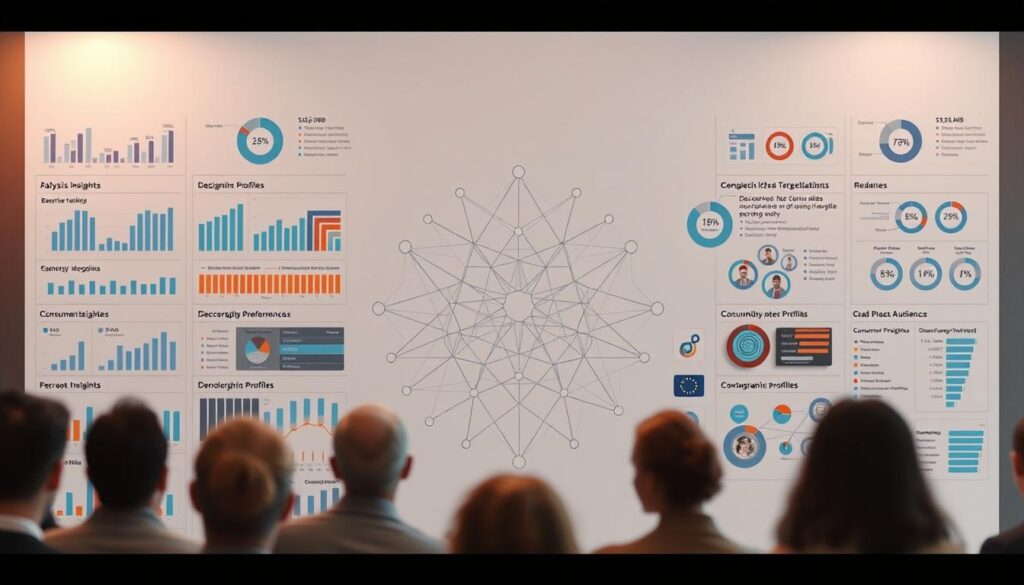As Albert Einstein once said, “The measure of intelligence is the ability to change.” In today’s fast-paced digital world, the ability to adapt and streamline workflows is more crucial than ever. Crafting high-quality prompts can significantly enhance the efficiency and relevance of generated material, making it a game-changer for creators.
Using tools like ChatGPT and specialized platforms such as Notion AI and HyperWrite, creators can generate ideas, outlines, and even full-length articles in minutes. These tools not only save time but also ensure consistency and quality across various formats, from blog posts to social media updates1.
For instance, ChatGPT has become a go-to resource for generating blog outlines, social media strategies, and even email content tailored to specific audiences1. Similarly, platforms like Narrato have shown that custom templates can reduce creation time by over 75%, making them invaluable for enterprise-level organizations1.
This article explores how well-crafted prompts can transform your workflow, offering practical tips and real-life examples to help you get started. Whether you’re a seasoned creator or just beginning, these insights will help you harness the power of intelligent tools to elevate your work.
Key Takeaways
- High-quality prompts improve the relevance and quality of generated material.
- Tools like ChatGPT and Narrato streamline content creation processes.
- Custom templates can reduce creation time significantly.
- Prompts help in generating diverse formats, from blogs to social media posts.
- Efficient workflows lead to better consistency and productivity.
Understanding AI Prompts for Content Curation and Scheduling

Modern creators are turning to advanced tools to enhance their workflows and meet audience demands. These systems rely on carefully crafted prompts to generate material that aligns with specific goals. A well-designed prompt can significantly improve the accuracy and relevance of the output, making it a cornerstone of efficient workflows2.
What Are Intelligent Prompts?
Intelligent prompts are instructions or questions designed to guide systems in producing tailored material. They act as the foundation for generating ideas, outlines, and even full-length articles. For example, a prompt like “Create a blog post about eco-friendly travel tips” can yield detailed and engaging content3.
These prompts are not just about generating text—they help refine strategies by aligning material with audience needs. By analyzing trends and preferences, creators can craft prompts that resonate with their target groups4.
The Impact on Strategy
Using intelligent prompts can transform how brands approach their marketing efforts. They enable the creation of personalized material that speaks directly to different audience segments. For instance, a campaign targeting environmentally conscious millennials can benefit from prompts that focus on sustainability3.
Moreover, these tools streamline the creation process, allowing brands to produce more without compromising quality. This efficiency is crucial in today’s fast-paced digital landscape, where staying relevant is key2.
By leveraging intelligent prompts, creators can ensure their material is not only consistent but also aligned with their overall strategy. This approach leads to better engagement and stronger connections with their audience4.
The Role of AI in Content Curation and Scheduling

Efficiency is the cornerstone of modern workflows, and tools are leading the charge. By automating routine tasks, these systems allow teams to focus on creativity and strategy. For instance, generating posts has never been faster, with tools scanning thousands of sources in seconds5.
Streamlining Creation Processes
Advanced systems simplify how posts are crafted. They analyze keywords, topics, and engagement metrics to identify relevant material5. This ensures that every post aligns with audience needs, saving time and effort for teams.
For example, Tech Startup X reported a 75% reduction in time spent on discovery and sharing5. This efficiency allows teams to focus on high-impact tasks, boosting overall productivity.
Enhancing Workflow Efficiency
Integrating these systems into workflows transforms how teams operate. They provide real-time monitoring, alerting users to trending topics and breaking news5. This keeps posts timely and relevant.
Moreover, tools offer in-depth analytics, tracking metrics like views, shares, and click-through rates5. By analyzing performance, teams can refine strategies and improve engagement.
“The right tool doesn’t just save time—it elevates the entire workflow.”
By leveraging these systems, teams can achieve better consistency and stronger connections with their audience. The result is a more efficient and impactful workflow.
Defining Your Audience for Targeted Content

Understanding your target audience is the foundation of any successful strategy. Without a clear picture of who you’re speaking to, your efforts may fall flat. By segmenting and analyzing your audience, you can create material that resonates deeply and drives engagement6.
Identifying Buyer Personas
Buyer personas are detailed profiles that represent your ideal customer. These profiles include demographics, behaviors, and pain points. For example, a persona for an eco-friendly brand might focus on environmentally conscious millennials7.
Creating these personas helps tailor your material to specific needs. Tools like surveys and analytics can provide valuable insights into your audience’s preferences and behaviors8.
Recognizing Influencer Impact
Influencers play a significant role in shaping audience perceptions. By collaborating with the right voices, you can amplify your message and reach a broader target audience7.
For instance, a partnership with a sustainability advocate can boost credibility for eco-friendly brands. This strategy not only increases visibility but also builds trust with your audience8.
“Knowing your audience is the first step to creating content that truly connects.”
By combining buyer personas and influencer insights, you can craft material that speaks directly to your audience’s needs. This approach ensures relevance and fosters stronger connections with your customer base6.
Choosing the Right AI Tools for Social Media and Content Creation

Selecting the right tools can make or break your strategy. With so many options available, it’s essential to find solutions that align with your goals and workflow. Notion AI and HyperWrite are two standout choices, each offering unique features to streamline your efforts.
Exploring Notion AI and HyperWrite
Notion AI is known for its versatility, helping users generate ideas, outlines, and even full-length articles. Its integration with other platforms makes it a favorite for teams looking to centralize their workflow9.
HyperWrite, on the other hand, excels in speed and efficiency. It’s designed to assist with writing tasks, from emails to social media posts, ensuring consistency across all channels10.
Comparing Popular Writing Assistants
When evaluating tools, consider features like social media integration and ease of use. For example, Hootsuite offers advanced analytics, making it ideal for larger companies9. Buffer, with its user-friendly design, is perfect for smaller teams9.
Tailwind is another excellent option, especially for Pinterest users. Its automated content creation and personalized marketing plans set it apart9.
“The right tool doesn’t just save time—it elevates the entire workflow.”
Ultimately, the best choice depends on your specific needs. Test free trials, compare features, and select a product that aligns with your strategy. This approach ensures you’ll find a tool that enhances your workflow and drives results.
Crafting Detailed and Contextual Prompts

The key to unlocking powerful results lies in the details of your approach. When creating instructions, clarity and specificity are essential. These elements ensure that the output aligns with your goals and resonates with your audience11.
Establishing Clear Context
Setting a clear context is the first step in generating useful responses. Without it, the results may be vague or irrelevant. For example, a prompt like “Write about travel” is too broad. Instead, “Create a blog post about eco-friendly travel tips in Europe” provides direction and focus12.
Context helps systems understand the topic and produce material that meets your needs. It also reduces the need for revisions, saving time and effort13.
Importance of Specific Instructions
Specific instructions minimize ambiguity and improve the quality of the output. For instance, instead of “Write a social media post,” try “Create a Facebook post promoting a new eco-friendly product, including a call-to-action.” This level of detail ensures the result is actionable and aligned with your strategy11.
Here are some tips for crafting effective prompts:
- Define the format (e.g., blog, email, social media).
- Include key details like audience, tone, and length.
- Use examples to guide the system’s understanding.
By following these steps, you can maximize the informational value of your prompts and achieve better results12.
“The right instructions don’t just save time—they elevate the entire process.”
In summary, detailed and contextual prompts are essential for generating high-quality material. By providing clear context and specific instructions, you can ensure your efforts are both efficient and effective13.
Brainstorming Content Ideas with AI

Innovation starts with the right approach to idea generation. With the help of advanced tools, creators can unlock fresh perspectives and streamline their brainstorming process. These tools analyze trends, preferences, and engagement patterns to deliver actionable insights14.
Prompting for Industry Trends
To stay ahead, it’s essential to focus on what’s trending in your industry. Tools can scan thousands of sources to identify emerging topics, ensuring your material remains relevant15. For instance, a prompt like “List the top 5 trends in sustainable fashion for 2024” can yield a detailed and actionable list14.
Providing context and background information in your instructions improves the accuracy of the output. This approach ensures the results align with your goals and resonate with your audience15.
Generating Target Group Specific Topics
Tailoring your ideas to a specific audience is key to engagement. By crafting prompts that focus on your target group’s needs, you can create material that speaks directly to them. For example, “Generate blog topics for eco-conscious millennials” can produce a list of highly relevant ideas14.
Experimenting with different prompt styles is crucial. Clear and specific instructions lead to more focused responses, avoiding vague outputs15. Here’s a step-by-step process to get started:
- Define your audience and their preferences.
- Use specific prompts to generate tailored ideas.
- Refine your instructions for clarity and precision.
“The right approach to brainstorming doesn’t just save time—it sparks creativity.”
By leveraging these strategies, you can overcome creative blocks and consistently produce fresh, engaging material. For more tips on enhancing your workflow, check out this guide.
Developing a Comprehensive Content Calendar

A well-structured plan is the backbone of any successful strategy. A calendar helps maintain a steady flow of material, ensuring consistency and relevance16. It’s a tool that transforms chaos into clarity, allowing teams to focus on creativity and execution.
Scheduling Social Media Posts and Blogs
Synchronizing social media updates and blog content is essential for maximizing engagement. By aligning these efforts, you can create a cohesive narrative that resonates with your audience17. For instance, a blog post about eco-friendly travel can be paired with social media posts highlighting related tips and visuals.
Here’s how to build a personalized plan:
- Define your goals using the SMART framework (Specific, Measurable, Achievable, Relevant, Time-bound)16.
- Analyze audience behavior to identify optimal posting times16.
- Use templates to streamline the process and save time17.
Best practices include tracking performance metrics and adjusting strategies based on engagement data16. Regularly updating your calendar ensures alignment with current trends and audience preferences17.
“Consistency is key to building trust and engagement with your audience.”
By following these steps, you can create a calendar that enhances productivity and drives results. Whether you’re managing a small team or a large organization, this approach ensures your efforts are both efficient and impactful.
Optimizing AI Prompts for Social Media Engagement

In the fast-paced world of social media, standing out requires more than just posting regularly. Crafting engaging content that resonates with your audience is key to boosting engagement. By tailoring your approach, you can transform generic posts into high-performing social media posts that drive results.
Effective Strategies for Platforms
Each platform has its unique audience and format. For example, Instagram thrives on visually appealing content, while Twitter favors concise, impactful messages. Tailoring your prompts to fit these differences ensures your posts resonate with the platform’s users18.
Posts with images receive 650% higher engagement than text-only posts18. Incorporating visuals into your strategy can significantly enhance your reach. Additionally, 75% of consumers expect a response to their inquiries within 24 hours, making timely interactions crucial18.
Enhancing Copy with Creative Prompts
Creative prompts can elevate your copy by adding personality and relevance. For instance, a prompt like “Write a caption for a travel photo that inspires wanderlust” can yield a compelling social media post. These prompts help align your content with your audience’s interests19.
Here are some actionable tips for crafting engaging posts:
- Use platform-specific formats and tones.
- Incorporate visuals and multimedia elements.
- Focus on storytelling to connect with your audience.
“The right prompt doesn’t just save time—it sparks creativity and drives engagement.”
By leveraging these strategies, you can create content that not only stands out but also fosters meaningful connections with your audience. For more insights on enhancing your social media strategy, check out this guide.
Integrating AI into Your Content Marketing Strategy

Blending traditional methods with advanced technologies can revolutionize your approach. This synergy allows businesses to enhance their marketing strategy while maintaining the core principles of effective communication. By leveraging these tools, companies can achieve greater efficiency and relevance in their campaigns20.
Enhancing Traditional Practices with Modern Insights
Advanced technologies bring a new dimension to conventional marketing practices. For instance, automating repetitive tasks can save up to 30% of the time spent on scheduling and monitoring20. This efficiency allows teams to focus on creativity and strategy, improving overall campaign quality20.
Businesses that integrate these tools report a 20% increase in content quality and engagement20. Analyzing audience behaviors and preferences leads to a 25% improvement in targeted content effectiveness20. These insights ensure that every piece of material resonates with the intended audience.
Aligning Tools with Company Goals
Aligning advanced solutions with company goals is crucial for success. By identifying trending keywords, businesses can increase organic search traffic by up to 40%20. This alignment ensures that all efforts contribute to the broader objectives of the organization.
Moreover, maintaining a consistent brand voice is essential. Studies show a 30% improvement in brand recognition when using these tools20. Regular audits of outputs help mitigate algorithm bias, ensuring relevance and trust20.
“The right integration doesn’t just save time—it elevates the entire marketing strategy.”
By following these steps, businesses can create a cohesive and impactful content marketing approach. Whether you’re a small team or a large enterprise, this strategy ensures your efforts are both efficient and effective.
Measuring the Impact of AI-Driven Content Strategies

Understanding the impact of your strategies is crucial for long-term success. By analyzing performance metrics, businesses can refine their approaches and achieve better results. This section explores methodologies and tools to measure effectiveness, ensuring your efforts are both efficient and impactful.
Tracking Engagement and Performance
To evaluate the effectiveness of your strategies, start by identifying key metrics. Engagement rates, click-throughs, and time spent on pages are essential indicators21. These metrics provide insights into how well your material resonates with your audience.
Tools like Flipboard and Feedly offer real-time analytics, helping you monitor performance and make data-driven decisions21. For example, businesses using these tools report a 25% increase in content effectiveness22. This data ensures your strategies remain aligned with audience preferences.
Here are some actionable steps to track performance:
- Set clear objectives to guide your measurement process.
- Use analytics tools to monitor engagement and conversions.
- Regularly update your strategies based on performance data.
“The right metrics don’t just measure success—they drive it.”
By leveraging these methodologies, you can optimize your strategies for better results. Continual improvement based on data ensures your efforts remain relevant and impactful in a fast-paced digital landscape.
Case Studies: Success Stories in AI-Powered Content Creation

Businesses across industries are witnessing transformative results through innovative approaches. By leveraging advanced tools, brands are achieving measurable improvements in efficiency and engagement. Let’s explore real-world examples that highlight the power of strategic implementations.
Real-World Examples of Increased Efficiency
One notable case involves a digital content creator who revamped her approach after conducting audience research. By tailoring her strategy to address specific needs, she grew her email newsletter subscribers from 41 to 2,61523. This shift not only improved engagement but also strengthened her connection with her target audience.
Another example comes from a pricing optimization firm that implemented an advanced chatbot on its website. This move led to a 17% increase in booked sales meetings and significantly boosted visitor engagement23. The firm’s ability to streamline interactions with its target audience showcased the potential of tailored solutions.
Video content has also played a pivotal role in driving success. A brand that focused on creating engaging video content for YouTube saw a 30% increase in engagement rates23. By aligning their strategy with platform-specific trends, they maximized their reach and impact.
Strategic Approaches to Enhance Production Quality
Leading companies are adopting innovative methods to improve production quality. For instance, Microsoft Digital used advanced tools to automate content creation, reducing turnaround times by 50%24. This approach not only saved time but also ensured consistency across all outputs.
Similarly, a team leveraging automated tools reported a 25% reduction in production time while maintaining high-quality standards23. These examples demonstrate how strategic implementations can lead to significant efficiency gains.
“The right tools don’t just save time—they elevate the entire process.”
For more insights on successful campaigns, explore this detailed case study. By learning from these examples, businesses can implement similar strategies to achieve their goals.
Addressing Common Challenges and Missteps with AI Prompts
Navigating the complexities of modern workflows often leads to unexpected hurdles. Many creators face difficulties when crafting instructions, resulting in outputs that miss the mark. Understanding these challenges is the first step toward refining your approach and achieving better results25.
Avoiding Poorly Crafted Instructions
One of the most frequent issues is the lack of clarity in instructions. Vague or overly broad inputs can lead to irrelevant or low-quality outputs. For example, a prompt like “Write about technology” is too general. Instead, “Create a LinkedIn article about the impact of AI on small businesses” provides specific direction26.
Another common misstep is neglecting context. Without it, the system may produce material that doesn’t align with your goals. Adding background information, such as audience demographics or tone preferences, ensures the output meets your needs27.
Here are some best practices to improve your approach:
- Define the format and purpose of the output.
- Include key details like audience, tone, and length.
- Use examples to guide the system’s understanding.
For instance, a LinkedIn article titled “5 Ways to Boost Engagement on Social Media” can serve as a template for future prompts. This practice ensures consistency and relevance across your material25.
“The right instructions don’t just save time—they elevate the entire process.”
By following these steps, you can avoid common pitfalls and create more effective instructions. Iterative testing and refinement are also crucial. Regularly reviewing and adjusting your approach ensures continuous improvement26.
For more insights, explore case studies and articles on LinkedIn that highlight successful strategies. These resources provide valuable lessons and actionable tips to enhance your workflow27.
Innovative Approaches for Future AI Content Trends
The future of digital engagement is being reshaped by groundbreaking innovations. As new tools and techniques emerge, marketers must adapt to stay ahead. The key lies in understanding how to leverage these advancements to create impactful strategies that resonate with evolving audience expectations28.
Emerging Techniques and Tools
One of the most significant shifts is the rise of hyper-personalized content. By analyzing user preferences, tools can now deliver tailored experiences that drive engagement29. For instance, platforms like Vocable provide insights into trending topics, helping marketers stay relevant28.
Another game-changer is the integration of predictive analytics. These tools forecast organic traffic and engagement, allowing for real-time adjustments to strategies30. This approach ensures that every piece of material aligns with audience needs and current trends.
Video content is also evolving rapidly. By 2025, 82% of internet traffic is expected to be video-based, particularly short-form videos28. Tools like InVideo make it easier to create visually appealing content that captures attention and drives results.
Preparing for Future Marketing Needs
To stay competitive, marketers must ask critical questions about their strategies. How can they adapt to new platforms and service models? What steps can they take to create engaging and adaptive copy that meets evolving social media standards29?
One effective strategy is to integrate advanced tools into existing workflows. For example, automating repetitive tasks like scheduling posts and writing personalized emails can save time and enhance efficiency28. This allows teams to focus on creativity and strategy, improving overall campaign quality.
Pioneering campaigns that use advanced features on diverse platforms are setting new benchmarks. By leveraging these innovations, brands can achieve higher engagement and stronger connections with their audience30.
“The future belongs to those who embrace innovation and adapt to change.”
By staying informed and proactive, marketers can prepare for future trends and ensure their strategies remain relevant and impactful. The key is to continuously explore new tools and techniques, integrating them seamlessly into existing workflows.
Conclusion
The digital landscape is evolving rapidly, and staying ahead requires innovative strategies. This article has explored how well-crafted instructions can streamline workflows, enhance creativity, and improve engagement. By leveraging advanced tools, creators can achieve their goal of producing high-quality material efficiently.
Integrating these solutions into your workflow not only saves time but also ensures consistency across platforms. Experimenting with different techniques can lead to more impactful results, as 85% of users found that tailored instructions significantly improved their ideation process31.
Looking ahead, the potential for these tools to transform practices is immense. As 61% of marketers already use them to boost efficiency, the future promises even greater advancements31. Start implementing these strategies today and measure your success to stay ahead in the ever-changing digital world.
FAQ
What are AI prompts and how do they work?
How can AI improve content strategy?
What role does AI play in content curation and scheduling?
How do I define my audience for targeted content?
Which AI tools are best for social media and content creation?
Why are detailed prompts important for AI content creation?
How can AI help brainstorm content ideas?
What are the benefits of using a content calendar?
How can AI prompts boost social media engagement?
How do I integrate AI into my content marketing strategy?
How do I measure the impact of AI-driven content strategies?
What are some real-world examples of AI-powered content success?
What challenges should I avoid when using AI prompts?
What are the future trends in AI content creation?
Source Links
- 100+ ChatGPT Prompts to Elevate Your Content Game
- Prompting 101: Writing prompts for AI
- How to Write AI Prompts + Tips for Generating AI Texts
- 6 AI Prompts for Small Business Marketing
- The ‘Smart’ Content Curator: How to Use AI to Share Relevant Industry News Effortlessly | Sunokrom
- 7 Generative AI Prompts To Help Your Content Marketing Workflows | Content Marketing Institute
- 26 ChatGPT Prompts for Social Media Marketing to Create Compelling Content
- The Complete Guide to AI for Content Strategy (2024)
- 11 Best Social Media Scheduling Tools (Reviewed)
- 12 Best AI Tools for Social Media in 2025
- 150+ of The Best ChatGPT Prompts for Content Creators
- AI agents for content generation: Capabilities, key components, use cases, benefits and trends
- 200 Chatgpt prompts for Digital Marketing | AI-Powered SEO
- 80+ AI Prompts for Social Media Post Generation
- 70 AI Prompt Examples for Marketers to Use in 2024
- AI-Powered Content Calendar: Boost Your Marketing Strategy
- Content Calendar Creation – AI Prompt
- AI Prompts for Social Media
- Top AI & ChatGPT Prompts for Social Media Post Generation
- AI for Content Marketing: Strategies, Tools, and Best Practices
- Harness AI Content Curation to Elevate Your Digital Strategy
- The Power of AI in Content Strategy: Revolutionizing the Way You Create and Optimize Content – Gigantic – Personalized Learning and Development meets Performance Management
- AI-Driven Case Studies: Streamline Content Creation Heading in 2025 – AI Digital Marketing Agency
- Reimagining content creation with our Azure AI-powered Inside Track story bot – Inside Track Blog
- A Framework for Navigating Generative Artificial Intelligence for Enterprise
- Ethical Challenges and Solutions of Generative AI: An Interdisciplinary Perspective
- Unlock Business Growth with AI: Boost Revenue & Enhance Customer Engagement | H2K Blog
- Top 10 AI Content Marketing Trends You Should Try for 2025
- How AI in Content Creation is Changing Digital Marketing
- AI in Content Creation: Market Growth and Adoption Trends
- Top AI tips and prompts to supercharge your content marketing







